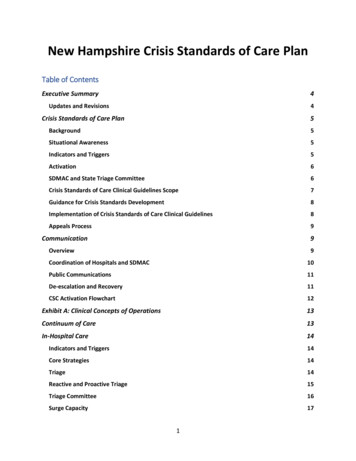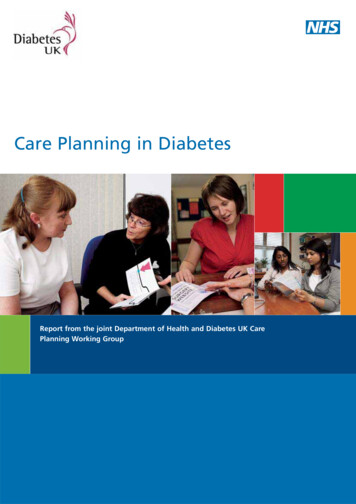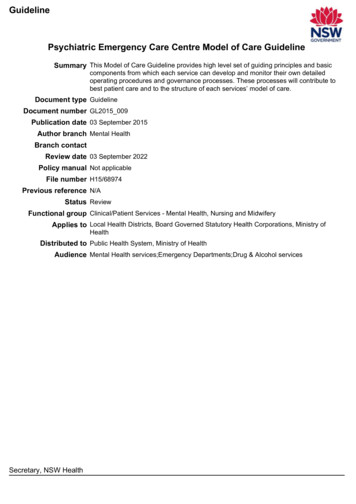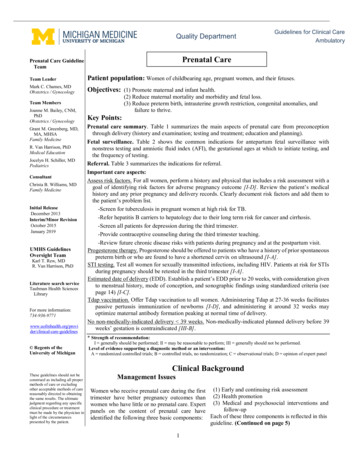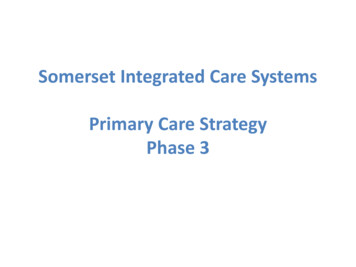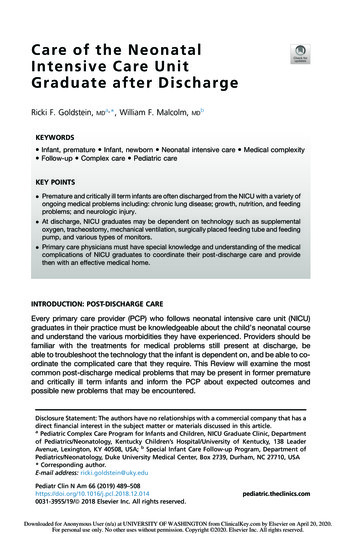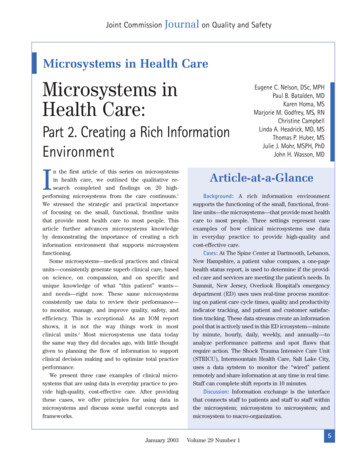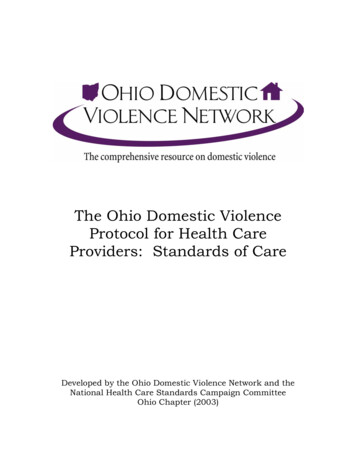
Transcription
The Ohio Domestic ViolenceProtocol for Health CareProviders: Standards of CareDeveloped by the Ohio Domestic Violence Network and theNational Health Care Standards Campaign CommitteeOhio Chapter (2003)
ODVN – Page 1The Ohio Domestic ViolenceProtocol for Health CareProviders: Standards of CareDeveloped by the Ohio Domestic Violence Network and theNational Health Care Standards Campaign CommitteeOhio Chapter (2003)
ODVN – Page 2IntroductionThe Ohio Domestic Violence Network (ODVN) is a statewide coalition of domesticviolence programs, support agencies and concerned individuals organizing to ensure theelimination of domestic violence by providing technical assistance, resources,information and training to all who address or are affected by domestic violence; andpromoting social and systems change through public policy, public awareness andeducation initiatives. Through our public policy efforts around health care we beganactively working with the Family Violence Prevention Fund.The National Health Care Standards Campaign (NSC) is an initiative created by theFVPF in 2000 that brought together fourteen states to create innovative public healthcampaigns against domestic violence. The National Standards Campaign-Ohio branchwas developed to identify the efficacy of the current medical response to victims ofdomestic violence in the state of Ohio and to identify what areas needed improvement.The NSC-Ohio is made up of individuals from a variety of fields, such as physicians,nurses, social workers and domestic violence advocates, who have a deep concern aboutthe lack of education health care providers receive related to working with victims ofdomestic violence.The experience of many committee members is that most health care providers feeluncomfortable discussing domestic violence with their patients or are unsure how tohandle disclosures about this issue. That is why the NSC developed the Ohio DomesticViolence Network Ohio Domestic Violence Protocol for Health Care Providers:Standards of Care. This protocol has been endorsed by the Ohio Chapter of theInternational Association of Forensic Nurses (IAFN), the Ohio Emergency NursesAssociation (ENA), the Ohio Department of Health (ODH), the Ohio Public HealthAssociation (OPHA), and the Ohio Chapter of the National Association of SocialWorkers (NASW). ODVN and the National Standards Campaign Committee wish toextend thanks to the Ohio Hospital Association (OHA) for the printing and assistancewith distribution of this protocol.For additional information or to obtain copies of this protocol contact:The Ohio Domestic Violence Network (ODVN)4807 Evanswood Drive, Suite 201Columbus, Ohio 43229Phone: 1-800-934-9840To obtain an electronic copy go to the ODVN website at www.odvn.orgThe Sexual Assault and Domestic Violence Prevention ProgramBureau of Health Promotion and Risk ReductionOhio Department of Health246 N. High Street, 8th floorColumbus, Ohio 43215Phone: 614/466-2144To obtain an electronic copy go to the ODH website 1.htm
ODVN – Page 3The Ohio Domestic Violence Network wishes to thank the National Health CareStandards Campaign –Ohio Chapter Committee members for all of their hard work anddedication to the development of the protocol.Julia Andrews, RN, SANE, LNC, Central Ohio Trauma System, ColumbusDru Bagley, Ohio Department of Health, ColumbusLiz Clark, MSW, LISW, Choices for Eliminating Domestic Violence, ColumbusRebecca Cline, LISW, Ohio Domestic Violence Network, ClevelandCharene Davis, RN, LISW, Brighter Futures/Help Me Grow, Greater Dayton Area Hospital AssociationRuth Downing, RN, SANE-A, Grady Memorial Hospital, DelawareAnn Fichtelman, RN, Mt. Carmel College of Nursing, ColumbusKate Foulke, BA, RA, Columbus Health Department, ColumbusJoyce Hersh, MS, Ohio Department of Health, ColumbusSandy Huntzinger, MSW, Ohio Domestic Violence Network, ColumbusCorina Klies, Ohio Coalition Against Sexual Assault, ColumbusJenifer Markowitz, ND, RNc, WHNP, The DOVE Program, Summa Health System, AkronJudi Moseley, Ohio Department of Health, ColumbusPaula Planey, Women’s Tri-County Help Center, St. ClairsvillePaula Renker, Ph.D., RNC University of Akron College of Nursing, AkronTheresa Singleton, YWCA of Greater Cincinnati, CincinnatiDeborah Stokes, MSSA, LISW, Ohio Department of Health, ColumbusPam Thomas-Groves, RN, SANE, Marion General Hospital, MarionKathy Yeater, RN, MS, CHES, Belmont County WIC program, BellaireTherese Zink, MD, MPH, University of Cincinnati Department of Family Medicine, Cincinnati
ODVN – Page 4Table of ContentsSummary of ProtocolBackgroundLegal ConsiderationsScreening for Domestic ViolenceAssessment and InterventionDocumentation46881216Appendices1 – What is Abuse?2 – Ohio Domestic Violence Law3 – Documentation Form Female4 – Documentation Form Male5 – Abuse Assessment Screen6 – Danger Assessment7 – Safety Plan8 – Specific Clinical Response9 – Interview and Screening Flow ChartReference Page18192122232425272930
ODVN – Page 5Ohio Domestic Violence NetworkDomestic Violence Protocol SummaryPurposeThe purpose of the Ohio Domestic Violence Network’s DV protocol is to providestandards of care for health care providers and agencies to address the needs of patient’sseeking health care who are victims of domestic violence. The essential components ofthe protocol include:Prepare Understand the physical, emotional, and financial impact of domestic violence. Be familiar with documenting and reporting guidelines for abuse in the OhioRevised Code 2321.22 (Appendix 2) Set the stage – Use environmental prompts that indicate your interest in domesticviolence. Wear pins that say “You can talk to me about family violence.” Putposters in your office and in women’s bathrooms about domestic violence andlocal resources. Leave safety cards with resource information and phone numbersin examination rooms and in women’s bathrooms.Screen Patients frequently do not present with obvious signs of domestic violence,therefore universal screening should be implemented. Specific guidelines forscreening are included in detail in the protocol. Patients should be screened atevery emergency room visit, during initial visits and annual physicals, eachhospital admission or screening and once each trimester during pregnancy.Ask privately – Do not ask when anyone else is in the room, including parents,partners, children over the age of 2, friends, or family members.Be honest – Describe why you are asking about domestic violence and what youwill be doing with the information. Inform patients about state laws regardingreporting domestic violence and child abuse. Patients need to know what you willand will not report.Ask general non-threatening questions to introduce the screen: “Do you feel safein your relationship? How does your partner treat you?”Ask about physical abuse “Have you been hit, slapped, kicked, or otherwisephysically hurt by anyone?” “Who?” Remember to ask about additionalperpetrators with teens – “Who else?” Ask about emotional abuse “Are youafraid of anyone?” or “Has anyone put you down or humiliated you? Ask aboutforced sex. “Has anyone forced you into having sex with them or becomingintimate with them against your will?” Remember that the perpetrator might beheterosexual or homosexual.Assess If you receive a positive response ask more questions about their domesticviolence history and their health status.
ODVN – Page 6 Ask how they cope or keep safe from violence. Listen for instances of use ofsubstances, unsafe coping measures, and isolating strategies. Are there childrenin the household at risk for harm?Evaluate the victim’s safety: fear of the abuser, use of alcohol /drugs, threats withweapons, increasing threats of severity of abuse, harm to children or pets, threatsof suicide or homicide. If any of these are positive, then discuss your concernabout patients’ safety and encourage them to seek help.Intervene Tell the patient that no one deserves to be hurt or put down. Affirm that it is hard to talk about abuse. Tell patients that they are not alone and that help is available. Reassure patients about confidentiality issues. Tell them that you will not revealinformation about their violence experiences with their families or perpetrators.Keep the chart and abuse documentation in a secure area isolated from visitors.Tell patients that you will treat their perpetrators like any other family member sothat you will not jeopardize their safety. Help patients to identify trusted individuals that they can approach for assistance. Discuss the importance of a safety plan. Help them to develop a plan or havethem call the domestic violence crisis or hot line number from your agency toassist them with this. Provide information about community agencies. Ask them if they need additional help in any way to complete their safety plan Tell them that they can contact the hospital, clinic, or doctor’s office forassistance between visits. Schedule a follow-up appointment.Document Include information in the medical record with as many direct quotes as possiblefrom the patient. Use a body map and photographs if there are bruises or scarspresent. Describe specific information about suggested resources and safetyplanning discussed during the interaction. Record the safety plan and referralsgiven to the woman.Evaluate Ask about how things are going with the relationship at follow-up visits. Patients may choose to never leave or live with the abuse for awhile beforechoosing to leave the relationship. Continue to show the patient how the stress ofthe abusive relationship affects health. Celebrate each step taken as a step toward keeping safe.Adapted from the ODVN Domestic Violence Protocol (2003) and Renker PR, (2003).This document may be reproduced.
ODVN – Page 7BackgroundPhilosophyThe Ohio Domestic Violence Network believes that all people are entitled to the right tolive free from violence or threat of violence from current or former partners. Becauseviolence against women poses an epidemic public health problem causing seriousphysical, psychological and social consequences, the following protocol has beendeveloped to provide direction to caregivers. Men and children can be victims of familyviolence and should also be screened. In order to differentiate men who are abused fromperpetrators of violence, providers should have appropriate training on domestic violencebefore screening this population.Because healthcare providers may be the first non-family member to whom an abusedindividual turns for help, the provider has an opportunity and responsibility to provideappropriate and sensitive interventions. Consistent with current Joint Commission for theAccreditation of Health Care Organizations (JCAHO) accreditation requirements andgood medical practice, the health care system is committed to developing andimplementing policies and procedures for identifying, treating, and referring victims ofdomestic abuse.PurposeThe purpose of the Ohio Domestic Violence Protocol is to provide standards of care forhealth care systems and providers to address the needs of individuals receiving care fordomestic violence within their systems. The protocol describes in detail how to screen,intervene and document when caring for individuals who are experiencing domesticviolence. The specific steps discussed include responses to patients who screen negativefor abuse as well as those who acknowledge violence.The protocol for those who screen positive for abuse includes a danger assessment, adetailed assessment of the physical and psychological state of the client, a safety plan,discharge instructions, referrals, and documentation issues. The protocol includesadditional information from the Family Violence Prevention Fund and other sources onscreening and intervention in domestic violence.The forms that are included in the protocol are intended to be completed by both thecaregiver and the patient. A reference list at the end of the protocol identifies thecontributing sources for the documents.Scope of the ProblemIn 1998, the National Violence Against Women Survey reported that more than one infour women surveyed acknowledged a history of intimate partner violence. Theprevalence of violence during pregnancy is especially significant, with 20% of womenover the age of 20 and 30-35% of adolescents reporting physical abuse during theperinatal period. Past research has focused on identification of intimate partner physical
ODVN – Page 8violence only. The prevalence would be much higher if emotional and sexual abuse wereincluded.Definition of Domestic ViolenceDomestic Violence, also called intimate partner violence (IPV), is an ongoing,debilitating pattern of physical, emotional, and/or sexual abuse involving force or threatof force, associated with increased isolation from the outside world and limited personalfreedom and accessibility to resources. A battered person is any person who has beenphysically injured or emotionally or sexually abused by a person from a current or pastintimate relationship. Specific definitions used in this protocol reflect guidelines providedby a Centers for Disease Control and Injury Prevention sponsored panel of experts fromthe government, private sector, and education/research arenas and published in IntimatePartner Violence Surveillance Uniform Definitions and Recommended Data Elements.These include: Physical abuse or violence: “The intentional use of physical force with thepotential for causing death, disability, injury or harm” (p.11) Sexual violence or abuse: “Use of physical force (and intimidation or pressure) tocompel a person to engage in a sexual act against her or his will, whether or notthe act is completed.” (p.12). Emotional or psychological abuse “ involving trauma to the victim caused byacts, or coercive tactics.” (p.62). Emotional abuse represents the psychologicalburden and consequences or trauma of physical and/or sexual assault as well asverbal and psychological abuse including humiliation, deprivation, and coercion.Other examples of emotional or psychological abuse are rooted in financial andsocial areas and include controlling money, use of the car, contact with friendsand family and other extracurricular activities. For example: frequent calls on thecell phone, monitoring voice mail or caller id history on the phone, hiding the carkeys or taking the battery out of the car so that they are late for work, settinglimits on who the victim can see and what they can do in their spare time.While the great majority of victims of domestic violence are female, it is important toremember that males can also experience domestic violence and that domestic violenceoccurs in both heterosexual and same sex relationships.Other examples of abuse are identified in Appendix 1, “What is Abuse?” written by theOhio Domestic Violence Network.Patterns of ViolenceScope and breadth of violence varies in relationships. However, three aspects remainconsistent: isolation, intimidation, and control. Domestic violence victims frequentlyfind themselves trapped as the violence increases in frequency and severity over time andmay demonstrate symptoms often seen in post-traumatic stress disorders. The goal of
ODVN – Page 9intervention is to return control and decision making to patients which increases theirability to stay safe.Legal ConsiderationsThe Ohio Revised Code 2919.25 (Appendix 2) defines domestic violence as a criminaloffense.Reporting RequirementsThe Ohio Revised Code (ORC section 2921.22) requires that health care providers whosuspect or identify that a woman is abused must document or write that assessment in thepatient’s medical record. Patients who identify that they have been abused can use theinformation recorded in the medical record at a later time for civil or criminal remedies.Only the abused patient can assess the danger and relative risk of reporting versus nonreporting. Health care providers are not required to report abuse to police or other legalauthorities unless the patient presents with injuries related to gunshot wounds, stabbings,second degree burns, serious injury and child or elder abuse (see ORC definitions inAppendix 2). Ohio does not have an explicit law requiring healthcare providers to reportsuspected instances of domestic violence. If the presenting injuries do not mandatereporting according to the ORC, health care providers only need to contact lawenforcement at the patient’s request.ConfidentialityConduct all interviews regarding domestic violence issues in private. Health careproviders should assure their patients that they will maintain confidentiality of thepatient’s disclosure and their medical records as permitted by law.Essential Steps: Screening, Assessment, Intervention, DocumentationScreening for Domestic ViolenceThe patient responses to screening must be carefully documented in order to be effective.Recording of the patients words in quotation marks will most accurately convey herpersonal experiences. Each step of subsequent violence assessment and interventionneeds to be documented. All three steps of screening, intervention, and documentationare essential to provide the necessary care for victims.Who should be screened?The National Consensus Guidelines developed by the Family Violence Prevention Fund(FVPF) include the following statement: “Patients should be screened for current andlifetime exposure to Intimate Partner Violence (IPV) and victimization including directquestions about physical, emotional, and sexual abuse. Because of the long-term impactof abuse on a patient’s health, we recommend integrating screening for current and
ODVN – Page 10lifetime exposure into routine care. However, we acknowledge there will be times(particularly in emergency/urgent care) when screening for lifetime exposure to abusewill not always be possible due to time constraints. Therefore the FVPF’srecommendations for screening are that: all adolescent and adult patients, as well as the parents or caregivers of children inpediatric care should be screened;all patients, regardless of cultural background or language barriers, should bescreened;the majority of IPV perpetrators are male, so screening all patients increases thelikelihood of screening perpetrators. We recommend routinely screening menonly if additional precautions can be taken to protect victims whose batterersclaim to be abused. Training providers on perpetrator dynamics is essential;health care providers learn that their responses to lesbian, gay, transgender,bisexual, and heterosexual victims is critical, regardless of whether the policy is toscreen all patients or women only.”While the ODVN supports the National Consensus Guidelines for screening, the purposeof this protocol is to address the needs of women and men over the age of 18. Additionalprotocols are necessary to address specific needs and concerns of minors, those withguardians, and the elderly population. Other concerns that need additional explorationand policy formation include violence in the lives of adolescents and screening of parentswho present with pediatric patients.Violence IndicatorsThe following information developed by the Family Violence Prevention Fund representsfindings that may suggest abuse. This list suggests some, but not all, of the indicators ofabuse. Any person seen in a health care setting may be a victim of abuse and should bescreened.Common Complaints Indication of having been hurt physically, sexually, and/or emotionally Unexplained injuries or injuries inconsistent with the history given Assaulted by alleged stranger Chronic pain syndrome, headaches Overdose/suicide attempts Anxiety, depression, insomnia, multiple somatic complaints Miscarriage, sexually transmitted diseases, and non-specific gynecologiccomplaints (e.g. pelvic pain, painful intercourse), as well as rapid repeatpregnancies and (unwanted) abortions Mu
Jenifer Markowitz, ND, RNc, WHNP, The DOVE Program, Summa Health System, Akron Judi Moseley, Ohio Department of Health, Columbus Paula Planey, Women’s Tri-County Help Center, St. Clairsville Paula Renker, Ph.D., RNC University of Akron College of Nursing, Akron



